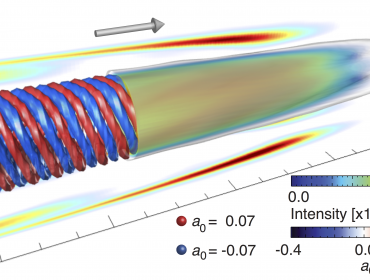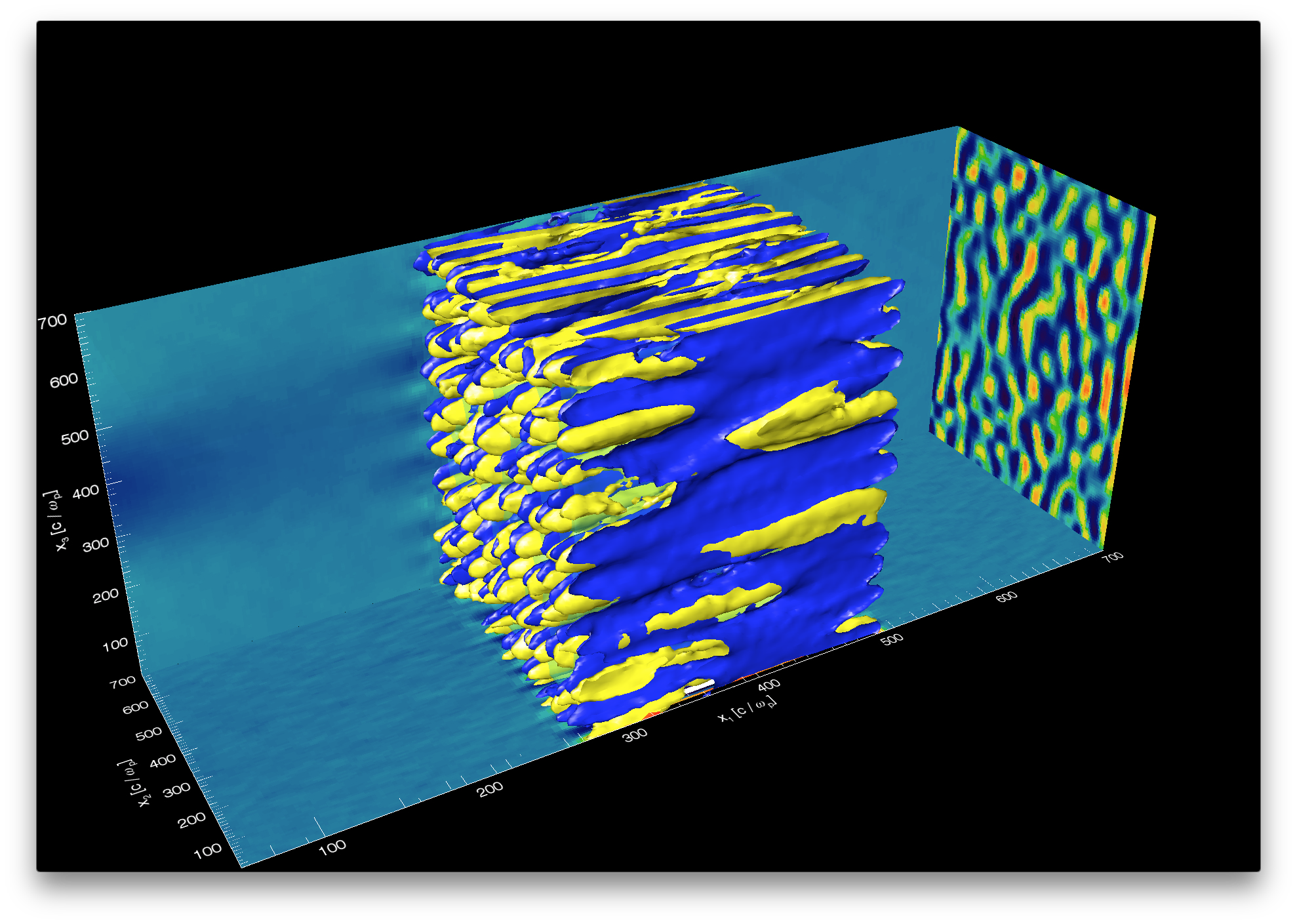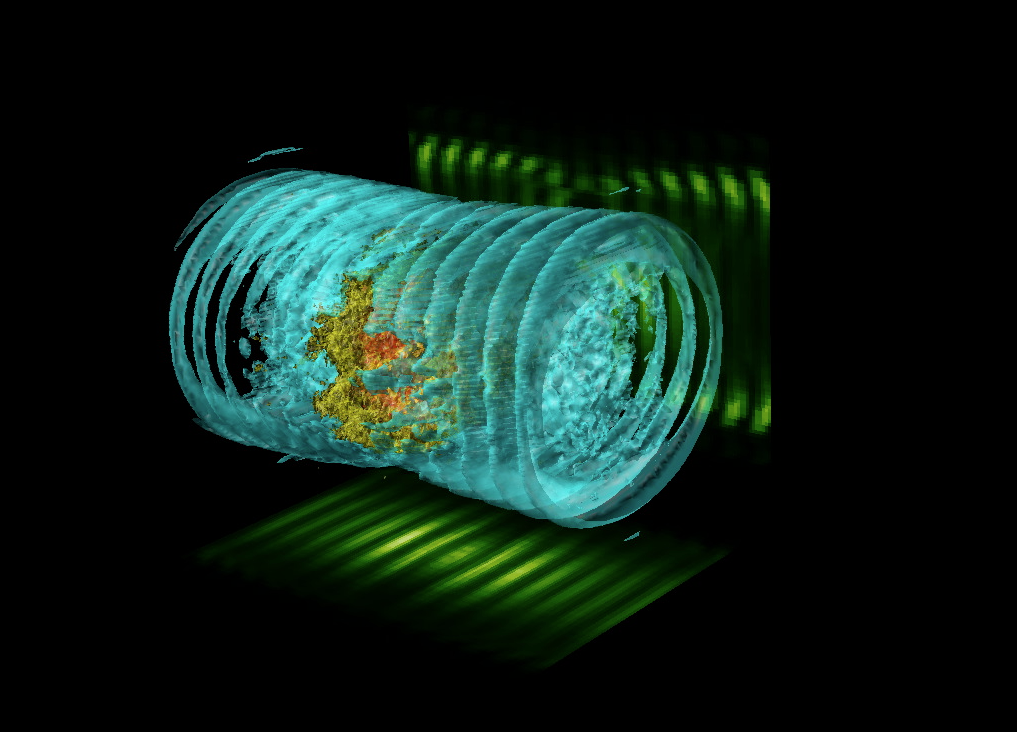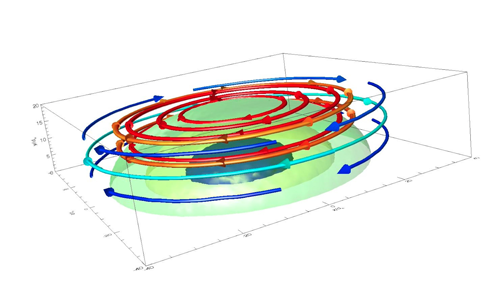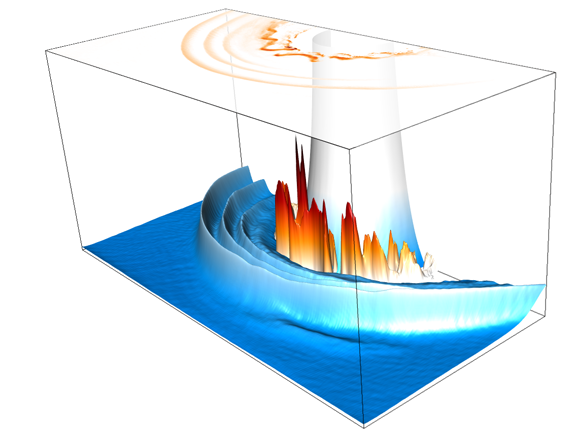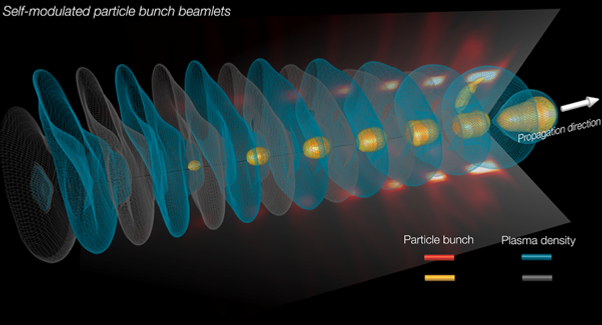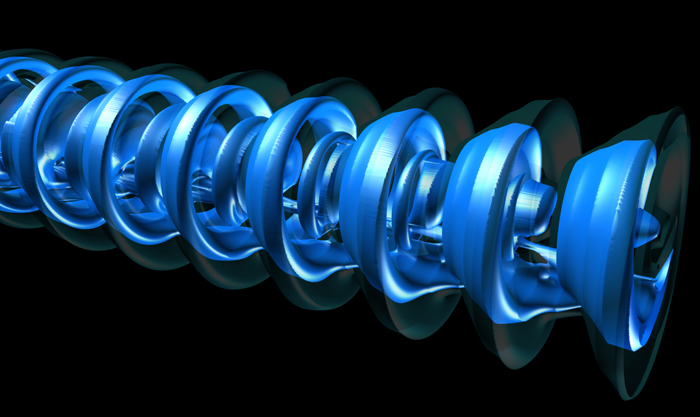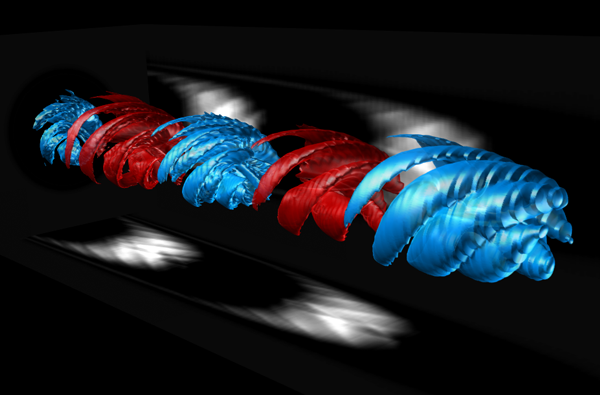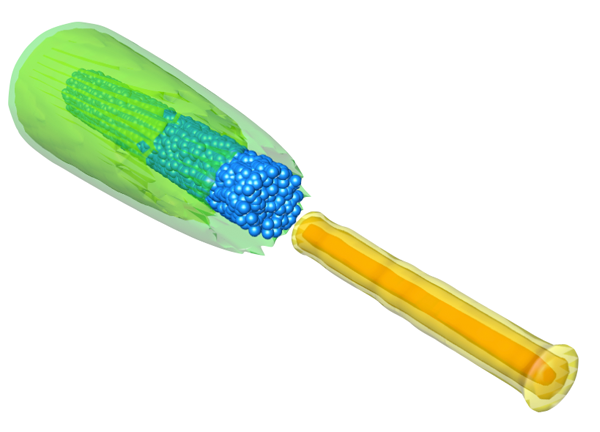-
Does light fly straight? In an optical tornado, it spins.
Read moreAn intense optical vortex beam, where light possess orbital angular momentum, can be understood as an optical analogue of a tornado, because of a spinning motion of photons in these beams. This exotic dynamics gives rise to exciting phenomena, with profound implications in science. The onset of many of their fascinating properties arises with nonlinear behaviours, which can be exploited only at very high laser intensities and in nontrivial optical media with higher order optical nonlinearities. Plasmas are an example of a nonlinear optical media where the striking nonlinear properties of twisted photons could be explored in depth. Plasmas are also an ideal medium to generate and amplify these beams to very high intensities, beyond breakdown thresholds of conventional materials. The image shows the result of a three dimensional particle-in-cell simulation using the massively parallel, fully relativistic particle-in-cell code Osiris, in a configuration that shows an intense beam of…
January 22, 2016 -
Filamentation of Solid target due to interaction of a Laser
Read moreFormation of counter-streaming plasma flow inside solid target
The movie shows the temporal evolution of the magnetic fields when a 140 fs laser pulse with focused intensity (I = 1016 W/cm2) hits on solid target (ne ~ 1022 cm−3). As the laser hits the target it generates fast electrons. In the beginning of the simulation, we initialised a warm background plasma electron isotropic temperature distribution. The background plasma ions form an immobile cold fluid background. The laser-plasma interaction then introduces an anisotropy in the electron temperature distribution. This anisotropy causes the growth of the Weibel instability, which consists in the formation of several electron current filaments that lead to the magnetic field structures shown in the movie. At the end of the movie, we can also observe the saturation of the Weibel instability, as the magnetic fields amplitudes stop growing exponentially. The Weibel instability is thought to play a critical…
February 6, 2015 -
An efficient light-matter-light converter
Read moreOne of the most striking nonlinear quantum effect is the production of an electron-positron pair by an electric field in vacuum. The probability of this process was determined by Schwinger in 1951 and shows that the production of electron-positron pairs is exponentially small for electric fields small compared to the Schwinger field (which is the field necessary for an electron or positron to gain its rest mass energy in a Compton length). Unfortunately, despite the tremendous progress observed in the development of ultra-intense lasers in the last decades, the electric fields generated by current lasers are many orders weaker than the Schwinger field, so that many effects have exponentially small probabilities and are therefore unobservable. One can nevertheless observe certain nonlinear quantum effects in fields small compared to the Schwinger field by using ultra relativistic particles such that the field amplitude in the rest frame of the particles will…
January 15, 2015 -
Magnetic field generation: the Biermann battery in action
Read moreMagnetic fields are ubiquitous throughout the universe, but their origin is still an open question. One of the most common explanations to this problem is that weak seed magnetic fields are amplified via turbulent mixing. Misaligned temperature and density gradients generated in shocks can provide this seed magnetic field via the Biermann battery mechanism.
This mechanism of magnetic field generation also plays an important role in laser-solid experiments. Lasers can ionize a solid film of metal or plastic and generate a temperature gradient with a maximum temperature in the center of the beam. The plasma has a density gradient with a decreasing density away from the target. As the newly ionized plasma expands, these perpendicular gradients drive the Biermann battery and can generate magnetic fields as high as megagauss. These fields have been detecte, for example, in experiments using the Omega EP lasers in Rochester, as well as in experiments…
November 19, 2014 -
Generation of miniature magnetised shockwaves
Read moreSolar wind is the name commonly associated with the stream of hot ionized gas, composed of free electrons and protons, released from the sun’s atmosphere. After its emission, the solar wind propagates in interplanetary space and interacts with several objects in our solar system, namely multi-scale magnetic fields. The interaction between the solar wind and earth’s magnetic field is responsible for the formation of our magnetosphere, which deflects the plasma around our planet. Earth’s magnetosphere prevents the solar wind from reaching earth’s atmosphere, protecting us from hazardous space radiation. Therefore, the detailed study of this interaction is relevant to understand space weather phenomena, which impact, for example, satellites operation.
In general, the typical scales of planetary magnetic fields are much bigger than the kinetic scales associated with the solar wind plasma, and this interaction is considerably well described using macroscopic frameworks like magnetohydrodynamics (MHD). However, when the magnetized object is…
November 19, 2014 -
Brillouin amplification: towards next generation laser energy densities
Read moreHigh-intensity lasers beams allow to create high-energy-density (HED) conditions, that mimic extreme astrophysical scenarios, in controlled laboratory settings. These exciting experiments give us a closer look at complex astrophysical processes that would otherwise have to be inferred indirectly by their radiation collected by our telescopes. Advances in the generation of higher laser powers and intensities is highly desirable, since these will give access to novel astrophysical conditions and exotic physical regimes of HED science, like “boiling the vacuum”.
Further increasing current state-of-the are laser energy densities is highly expensive using solid state optics. Unfeasibly massive gratings, mirrors and lenses are required to manage impinging laser intensities below their damage threshold. Plasma-based laser amplifiers, leveraging on parametric processes like stimulated Brillouin backscattering, overcome the optical damage limitations of solid state optics by several orders of magnitude, providing a promising alternative to the production of next generation laser energy densities.
Stimulated Brillouin backscattering…
November 19, 2014 -
Competition between self-modulation and hosing instability in self-modulated wakefield acceleration
Read moreAs conventional particle acceleration techniques are hitting technological limits, plasma based acceleration is emerging as a leading technology in future generations of higher energy, compact particle accelerators. Although initially proposed more than 30 years ago by Prof. T. Tajima and Prof. J. Dawson at the University of California in Los Angeles (UCLA), the first ground breaking plasma acceleration experimental results appeared in 2005. Plasma acceleration is presently an active field of research, being pursuit by several leading laboratories (e.g. SLAC, DESY, RAL, LOA, LBNL).
Electron or positron acceleration in plasma waves is similar to sea wave surfing. Plasma accelerators use an intense laser pulse or particle bunch (boats on water) as driver to excite relativistic plasma waves (sea waves for surfing). Accelerating structures are sustained by plasma electrons and are not affected by physical boundary effects as in conventional accelerators. The plasma accelerator only lasts for the driver transit time…
November 19, 2014 -
Orbital angular momentum cascading in stimulated Raman backscatering
Read moreTailoring a laser pulse for a given application typically refers to manipulating its duration, frequency and intensity profile. Recently, it has been found that lasers could also be produced with Orbital Angular Momentum, or OAM. Given the tremendous potential of the role of OAM in many technological applications and scientific research domains, ranging from super-resolution microscopy and quantum computation, to optical manipulation of nanostructures and ultra-fast communications in optical fibers, it is fair to now state that OAM is in equal foot to its duration, frequency and intensity, a fundamental laser feature.
Lasers with OAM have spiralling wave vectors and a spiralling phase. As a result, surfaces of the laser with identical electric or magnetic field amplitudes spiral along the laser. In addition, the laser intensity profile resembles a doughnut. The potential of these lasers to explore relativistic laser plasma interactions has just started to be unraveled in the field…
November 19, 2014 -
Twisted plasma waves with orbital angular momentum
Read moreThe advent of lasers with Orbital Angular Momentum (OAM), with their spiralling wavefronts and doughnut shaped intensity profiles, is opening new research directions in ultra-high intensity laser plasma interactions. For instance, it has been shown that OAM lasers could lead drive plasma waves with exotic electromagnetic structures ideally suited to produce energetic electrons and positrons for applications.
There are regimes where the laser OAM can be transfered to the plasma wave, but its impact in ultra-intense laser plasma interactions is still rather unexplored. In the example illustrated by the image, showing plasma density isosurfaces (i.e. three-dimensional surfaces connecting regions of identical plasma density), reveals a OAM plasma wave with visible spiralling density structures.
November 19, 2014 -
Tightly focused positron beams drive a plasma hollow-channel
Read morePlasma wakefield accelerators can sustain higher accelerator gradients than conventional accelerators, exceeding 100GV/m. In order to reach the highest acceleration gradients the typical configuration used consists of an intense and short electron or laser drive beam that propagates in a plasma in the so-called non linear blowout regime where they excite relativistic plasma wake fields. In this blowout regime the plasma electrons are expelled radially from the beam axis while the remaining and immobile background plasma ions form a positively charged bubble that attracts the electrons back to beam axis, leading to both electron acceleration and focusing. However, the focusing fields generated in such configuration are too narrow to enable efficient positron acceleration and given the relevance of positron acceleration for future plasma based linear colliders, alternative acceleration techniques have been proposed and explored. In particular, the use of hollow channels for positron acceleration in linear regimes has been…
November 19, 2014
extreme plasma physics > Visualizations

